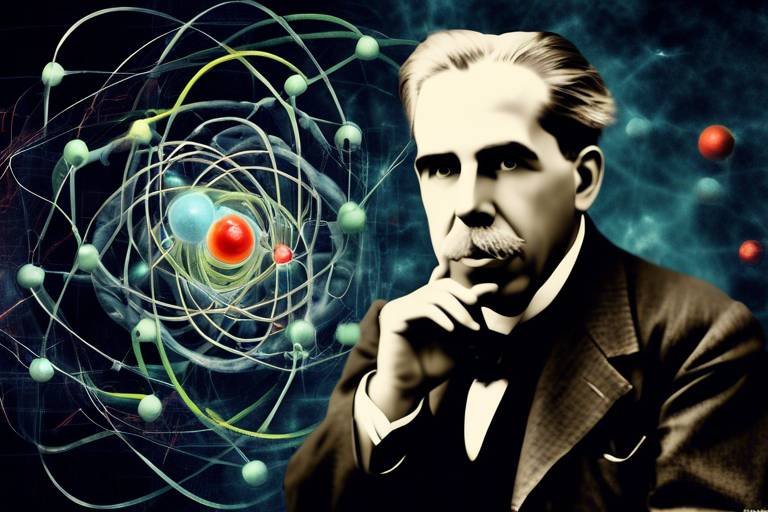The Groundbreaking Research of Barbara McClintock in Genetics
Throughout the annals of scientific history, few figures have made as profound an impact on the field of genetics as Barbara McClintock. Her groundbreaking research not only reshaped our understanding of genetic variability but also paved the way for future discoveries in molecular biology. McClintock's journey into the world of genetics is akin to a thrilling adventure, where every twist and turn revealed new insights into the complex tapestry of life. Imagine opening a book where every page uncovers a hidden secret about how organisms evolve and adapt—this was the essence of McClintock's work.
Born on June 16, 1902, in Hartford, Connecticut, Barbara's fascination with nature began at a young age. She was encouraged by her parents, who nurtured her curiosity and love for science. This early exposure to the wonders of the natural world would later serve as the foundation for her scientific endeavors. McClintock pursued her education at Cornell University, where she was one of the few women in her field at the time. Her determination and passion for genetics propelled her forward, despite the societal challenges she faced as a woman in science.
McClintock's most notable achievement was the discovery of transposable elements, often referred to as "jumping genes." This discovery was revolutionary, akin to finding a hidden treasure map that explained how genes could move around within the genome. Before her work, the prevailing belief was that genes were static, locked in place like stones in a wall. However, McClintock's research demonstrated that certain genes could change their positions, leading to variations in traits and inheritance patterns. This revelation not only transformed the understanding of genetics but also opened new avenues for research in evolutionary biology, molecular genetics, and biotechnology.
Her research on maize, or corn, was particularly significant. By meticulously studying the genetic makeup of corn plants, McClintock uncovered the dynamic nature of the genome and its ability to respond to environmental factors. This was not just a scientific breakthrough; it was a paradigm shift that challenged long-held beliefs about genetic stability. She developed innovative cytogenetic techniques that allowed her to visualize and track these genetic changes, which were groundbreaking at the time. Imagine being able to watch genes dance and shift within the chromosomes—this was the reality McClintock created through her experiments.
Despite facing skepticism from her contemporaries, McClintock's contributions eventually garnered the recognition they deserved. In 1983, she was awarded the Nobel Prize in Physiology or Medicine, a testament to her enduring impact on the field of genetics. This accolade was not merely a personal triumph; it was a victory for all women in science, illuminating the path for future generations to follow. McClintock's legacy is one of resilience, innovation, and inspiration, encouraging countless scientists, particularly women, to pursue careers in genetics and related fields.
Today, the implications of McClintock's discoveries are more relevant than ever. Her work laid the groundwork for advancements in biotechnology, including gene therapy, crop improvement, and the study of genetic diseases. As we continue to unravel the complexities of the genome, McClintock's pioneering spirit reminds us that the journey of discovery is ongoing. Her research serves as a beacon of hope and possibility, demonstrating that the secrets of life are still waiting to be uncovered.
- What are transposable elements?
Transposable elements, or "jumping genes," are segments of DNA that can move around within the genome. They play a crucial role in genetic variability and adaptation. - Why is Barbara McClintock significant in genetics?
Barbara McClintock is significant for her discovery of transposable elements, which transformed our understanding of genetics and inheritance. - What awards did Barbara McClintock receive?
She received numerous awards, including the Nobel Prize in Physiology or Medicine in 1983, for her groundbreaking work in genetics. - How did McClintock's research influence modern biotechnology?
Her discoveries laid the foundation for gene therapy, crop improvement, and the study of genetic diseases, making her work crucial in the field of biotechnology.

Early Life and Education
Barbara McClintock was born on June 16, 1902, in Hartford, Connecticut, into a family that valued education and intellectual curiosity. From a young age, she showed a keen interest in science, often exploring the natural world around her. Her father, a corn breeder, played a significant role in sparking her fascination with plants and genetics. It was in this nurturing environment that her scientific journey began, fostering her inquisitive mind and laying the groundwork for her future groundbreaking discoveries.
McClintock attended the New York State College of Agriculture at Cornell University, where she pursued her undergraduate studies in botany. She was one of the few women in her program, facing the challenges of a male-dominated field. Despite these obstacles, her determination shone through, and she graduated with a Bachelor of Science degree in 1923. Her passion for research led her to continue her studies at Cornell, where she earned her Master's degree in 1925, focusing on the genetics of maize. This period was pivotal, as it introduced her to the complexities of genetic inheritance and the experimental techniques that would define her career.
During her time at Cornell, McClintock was mentored by some of the leading scientists of the day, including the renowned geneticist George Beadle. His encouragement and guidance were instrumental in shaping her research approach. After completing her Master's degree, she pursued her Ph.D. in the same field, which she obtained in 1927. Her doctoral research on the chromosomal structure of maize not only showcased her innovative spirit but also set the stage for her future explorations into the world of transposable elements.
McClintock's early education was characterized by her relentless pursuit of knowledge and her resilience in overcoming gender barriers in science. She often faced skepticism from her peers, yet she remained undeterred, driven by her passion for understanding the intricacies of genetics. In a time when women were often discouraged from pursuing careers in science, McClintock's journey became a beacon of inspiration for future generations of female scientists.
In summary, Barbara McClintock's early life and education were marked by a profound curiosity about the natural world, a strong academic foundation, and the unwavering support of mentors who recognized her potential. These experiences not only shaped her as a scientist but also set the stage for her revolutionary contributions to genetics, ultimately leading to her recognition as one of the most important figures in the field.

Discovery of Transposable Elements
Barbara McClintock's discovery of transposable elements, often referred to as "jumping genes," was nothing short of revolutionary. Imagine a world where the rules of genetics were rigid and unchanging; McClintock shattered that illusion, unveiling a dynamic and unpredictable landscape of genetic variability. Her work fundamentally altered our understanding of how genes operate within the genome, revealing that certain segments of DNA can move from one location to another, effectively altering the genetic makeup of the organism.
At the heart of her groundbreaking research was a series of meticulous experiments conducted on maize (corn). McClintock observed that the color of corn kernels could vary significantly, a phenomenon she attributed to the movement of genetic elements within the plant's DNA. This observation led to her hypothesis that some genes were not fixed but rather could change their positions, influencing traits and inheritance patterns. It was as if she had discovered a hidden dance within the genome, where genes could leap and twirl, changing the choreography of heredity itself.
To understand the significance of her findings, it’s essential to recognize the context in which she was working. Before McClintock's discoveries, the prevailing view of genetics was largely deterministic. Genes were thought to be static, contributing to specific traits in a predictable manner. However, her work revealed that genetic information is more like a flexible tapestry, woven together with threads that can shift and rearrange, leading to a rich diversity of traits. This insight opened the door to new questions about genetic regulation and how organisms adapt to their environments.
McClintock's innovative use of cytogenetic techniques allowed her to visualize these changes in real-time. By employing techniques such as chromosome staining and microscopy, she could track the movement of these transposable elements, providing compelling evidence for their existence. The ability to see these genetic "jumps" in action was a game-changer, offering a tangible demonstration of how genetic variability could arise and be inherited.
As her findings began to gain traction, McClintock's work prompted a reevaluation of genetic theories across various fields. The implications of her discoveries extended far beyond maize, influencing our understanding of genetic mobility in all living organisms. Researchers began to explore how these "jumping genes" could play a role in evolutionary biology, suggesting that genetic variability might be a driving force behind adaptation and speciation.
In summary, Barbara McClintock's discovery of transposable elements not only transformed the field of genetics but also challenged and expanded our understanding of how genes interact with one another and their environment. Her work laid the groundwork for future research into gene regulation and genetic engineering, demonstrating that the genome is not a static blueprint but a dynamic, evolving entity. This revelation has profound implications for modern biology, as it encourages scientists to embrace complexity and variability in their studies.

jumping genes
This article explores the revolutionary contributions of Barbara McClintock to the field of genetics, including her discovery of transposable elements and their implications for modern biology.
Barbara McClintock's formative years and academic journey laid the foundation for her pioneering work in genetics, showcasing her early interests and the influences that shaped her scientific perspective.
McClintock's groundbreaking discovery of transformed the understanding of genetic variability, revealing how certain genes can change positions within the genome and affect inheritance. This concept of transposable elements, or "jumping genes," was revolutionary because it challenged the traditional view of genes as static entities. Instead, McClintock demonstrated that genes could be mobile, altering their positions on chromosomes and thereby influencing the traits of an organism.
Her research on maize provided crucial insights into genetic regulation and the mechanisms of inheritance, demonstrating the dynamic nature of the genome and its response to environmental factors.
McClintock employed innovative experimental methods, including cytogenetic techniques, to visualize and track genetic changes in maize, which contributed significantly to her findings on transposable elements.
The implications of her discoveries extend into evolutionary biology, prompting researchers to reconsider the role of genetic mobility in adaptation and evolution across species.
Despite initial skepticism from the scientific community, McClintock eventually received widespread recognition for her work, including the Nobel Prize in Physiology or Medicine in 1983, highlighting her lasting impact on genetics.
McClintock's contributions continue to influence contemporary genetic research, inspiring new studies on gene regulation, genetic engineering, and the understanding of complex traits in various organisms.
Her pioneering work has inspired countless scientists, particularly women in the field, encouraging them to pursue careers in genetics and related disciplines, thereby shaping the future of biological research.
Today, McClintock's discoveries are foundational in biotechnology, influencing applications such as gene therapy, crop improvement, and the study of genetic diseases, demonstrating the enduring relevance of her research.
- What are jumping genes?
Jumping genes, or transposable elements, are segments of DNA that can move around to different positions within the genome of a single cell. They can disrupt normal gene function, which can lead to genetic diversity and adaptation.
- Why are jumping genes important?
They play a crucial role in genetic variation and evolution. Their ability to move can lead to new traits in organisms, which can be beneficial for adaptation to changing environments.
- How did Barbara McClintock discover jumping genes?
Through her meticulous studies of maize, McClintock observed unusual patterns of inheritance that couldn't be explained by Mendelian genetics, leading her to propose the existence of mobile genetic elements.
- What impact did McClintock's work have on modern genetics?
Her discoveries laid the groundwork for understanding gene regulation and the complexities of the genome, influencing fields such as genetic engineering and biotechnology.

transformed the understanding of genetic variability, revealing how certain genes can change positions within the genome and affect inheritance.
This article explores the revolutionary contributions of Barbara McClintock to the field of genetics, including her discovery of transposable elements and their implications for modern biology.
Barbara McClintock's formative years and academic journey laid the foundation for her pioneering work in genetics, showcasing her early interests and the influences that shaped her scientific perspective.
McClintock's groundbreaking discovery of jumping genes transformed the understanding of genetic variability, revealing how certain genes can change positions within the genome and affect inheritance. This concept was revolutionary because it challenged the long-standing belief that genes were fixed in place, like landmarks on a map. Instead, McClintock demonstrated that genes could move around, akin to a game of musical chairs, where the players (genes) change their positions and, in doing so, alter the outcome of the game (inheritance).
Her research on maize provided crucial insights into genetic regulation and the mechanisms of inheritance, demonstrating the dynamic nature of the genome and its response to environmental factors.
McClintock employed innovative experimental methods, including cytogenetic techniques, to visualize and track genetic changes in maize, which contributed significantly to her findings on transposable elements.
The implications of her discoveries extend into evolutionary biology, prompting researchers to reconsider the role of genetic mobility in adaptation and evolution across species.
Despite initial skepticism from the scientific community, McClintock eventually received widespread recognition for her work, including the Nobel Prize in Physiology or Medicine in 1983, highlighting her lasting impact on genetics.
McClintock's contributions continue to influence contemporary genetic research, inspiring new studies on gene regulation, genetic engineering, and the understanding of complex traits in various organisms.
Her pioneering work has inspired countless scientists, particularly women in the field, encouraging them to pursue careers in genetics and related disciplines, thereby shaping the future of biological research.
Today, McClintock's discoveries are foundational in biotechnology, influencing applications such as gene therapy, crop improvement, and the study of genetic diseases, demonstrating the enduring relevance of her research.
- What are transposable elements?
Transposable elements, often referred to as "jumping genes," are segments of DNA that can move around within the genome, impacting genetic variability and inheritance.
- How did Barbara McClintock contribute to genetics?
McClintock's research on maize led to the discovery of transposable elements, changing our understanding of how genes can relocate within the genome and affect traits.
- Why is McClintock's work significant today?
Her findings laid the groundwork for advancements in genetic engineering, biotechnology, and our understanding of genetic diseases.

Significance in Corn Genetics
Barbara McClintock's research on maize, commonly known as corn, was nothing short of revolutionary. Her groundbreaking work revealed the intricate dance of genetic regulation and highlighted how genes are not static but rather dynamic entities that can shift and change depending on various factors. Imagine a stage where the performers—the genes—can change their roles and positions, creating an entirely different performance each time. This metaphor perfectly encapsulates the essence of McClintock's findings.
Through her meticulous studies, McClintock demonstrated that certain genes could move within the genome, a phenomenon she famously termed transposable elements or "jumping genes." These elements play a crucial role in genetic variability, allowing organisms to adapt to their environments. This was particularly evident in her work with corn, where she observed how these jumping genes influenced the color of the kernels. The implications of her discoveries extended beyond mere aesthetics; they opened the door to understanding how genetic traits are inherited and expressed.
One of the most significant impacts of her research was the realization that the genome is not a fixed entity but rather a fluid and responsive system. This understanding shifted the paradigm in genetics, encouraging scientists to explore the complexities of genetic interactions and environmental influences. McClintock's findings on corn genetics paved the way for advancements in various fields, including agriculture and plant breeding, where the principles of genetic mobility are applied to enhance crop resilience and yield.
In a broader context, McClintock's work has implications for evolutionary biology as well. By illustrating how genes can move and adapt, she challenged the traditional views of evolution that focused solely on fixed genetic traits. Instead, her research suggested that genetic mobility could be a driving force in the adaptation of species over time. This perspective has led to new avenues of research, prompting scientists to reconsider the mechanisms of evolution and adaptation across various organisms.
In summary, Barbara McClintock's contributions to corn genetics were not just about understanding maize; they were about unlocking the mysteries of genetics itself. Her pioneering spirit and innovative techniques have left an indelible mark on the field, inspiring future generations to delve deeper into the complexities of genetic science. As we continue to explore the vast landscape of genetics, McClintock's legacy serves as a guiding light, reminding us of the profound interconnectedness of life and the dynamic nature of our genetic makeup.

Experimental Techniques
Barbara McClintock was not just a brilliant mind; she was an innovator in the lab, employing a range of that were ahead of her time. Her work on maize, or corn, was not merely observational; it was a meticulous exploration of the genetic landscape that involved a deep understanding of cytogenetics. This branch of genetics focuses on the structure and function of chromosomes, and McClintock used it to her advantage to visualize the genetic changes that occurred within the maize genome.
One of her most notable techniques was the use of chromosome staining, which allowed her to observe the physical structure of chromosomes under a microscope. By applying specific dyes, she could highlight different regions of the chromosomes, making it easier to identify where genes were located and how they behaved during cell division. This was crucial in her discovery of transposable elements, as she could see how these "jumping genes" moved from one location to another within the genome.
Additionally, McClintock utilized genetic mapping techniques to track the inheritance patterns of traits in maize. By creating detailed maps of the maize genome, she could correlate specific traits with their corresponding genetic loci. This was akin to drawing a treasure map, where each trait was a hidden gem waiting to be uncovered. Her innovative approach allowed her to demonstrate that genes could not only be stable but also dynamic, shifting their positions and altering their effects on the organism.
In her experiments, she also employed cross-breeding methods, which involved mating different strains of maize to observe the resulting offspring. This technique enabled her to study the inheritance of traits and identify the presence of transposable elements. The results of her cross-breeding experiments were nothing short of revolutionary, as they revealed the complexity of genetic inheritance and the role of environmental factors in shaping genetic expression.
To summarize, McClintock’s experimental techniques were a blend of creativity and scientific rigor. Her ability to visualize genetic changes, create genetic maps, and conduct cross-breeding experiments paved the way for her groundbreaking discoveries. These methods not only contributed to her understanding of transposable elements but also established a foundation for future genetic research. Her work serves as a reminder that sometimes, the most profound discoveries come from the most innovative approaches in the lab.
- What are transposable elements?
Transposable elements, often referred to as "jumping genes," are sequences of DNA that can change their position within the genome, impacting gene expression and genetic variability.
- How did Barbara McClintock's work influence modern genetics?
Her discoveries laid the groundwork for understanding genetic regulation, gene therapy, and the role of genetic mobility in evolution, influencing a wide range of contemporary genetic research.
- What techniques did McClintock use in her research?
She employed chromosome staining, genetic mapping, and cross-breeding methods to explore the dynamics of the maize genome and the behavior of transposable elements.

Impact on Evolutionary Biology
Barbara McClintock's discoveries have had a profound impact on the field of evolutionary biology, reshaping our understanding of how organisms adapt and evolve over time. Her identification of transposable elements, often referred to as "jumping genes," revealed a dynamic aspect of the genome that was previously overlooked. This groundbreaking insight prompted scientists to rethink the mechanisms of genetic variation and inheritance, leading to a more nuanced view of evolution.
Before McClintock's work, the prevailing belief was that genetic changes occurred primarily through mutations that were stable and unchanging. However, her research demonstrated that genes could move within and between chromosomes, introducing a level of genetic variability that could be harnessed by natural selection. This flexibility in the genetic code opened up new avenues for understanding how organisms can quickly adapt to changing environments, highlighting the importance of genetic mobility in the evolutionary process.
Moreover, McClintock's findings have led to several important implications in evolutionary biology:
- Adaptive Evolution: The ability of organisms to shuffle their genetic material allows for rapid adaptation in response to environmental pressures. This has been particularly evident in plant species, which can adjust their traits to survive in varying conditions.
- Genomic Flexibility: The presence of transposable elements adds a layer of complexity to the genome, enabling organisms to explore a wider range of genetic possibilities. This flexibility can lead to the emergence of new traits that may confer survival advantages.
- Evolutionary Developmental Biology: McClintock's work has inspired research into how genetic changes influence developmental processes, leading to a better understanding of how evolutionary changes are manifested in physical traits.
In essence, McClintock's research has encouraged evolutionary biologists to consider the role of genetic mobility as a driving force behind adaptation and speciation. It has shifted the focus from a static view of genetics to one that embraces the dynamism of the genome, emphasizing that evolution is not merely a slow, gradual process but can also involve rapid changes driven by the movement of genes. This perspective has opened up new research avenues, allowing scientists to explore the intricate relationships between genetics, evolution, and the environment.
- What are transposable elements?
Transposable elements, or "jumping genes," are sequences of DNA that can change their position within the genome, leading to genetic variability. - How did McClintock's work influence evolutionary biology?
Her discoveries highlighted the role of genetic mobility in adaptation, prompting a reevaluation of how organisms evolve in response to environmental changes. - Why is McClintock's research still relevant today?
Her findings laid the groundwork for modern genetic research, influencing areas like gene therapy, biotechnology, and our understanding of complex traits in various organisms.

Recognition and Awards
Barbara McClintock's journey in the scientific world was not without its challenges. Initially, her groundbreaking ideas about transposable elements were met with skepticism and resistance from the broader scientific community. Many of her contemporaries found it hard to accept the notion that genes could move around within the genome, a concept that seemed almost fantastical at the time. However, as more evidence emerged to support her claims, the tide began to turn. McClintock's persistence and dedication to her research eventually led to a series of well-deserved accolades that recognized her contributions to genetics.
One of the most significant milestones in her career was the Nobel Prize in Physiology or Medicine, which she received in 1983. This award was a monumental acknowledgment of her pioneering work and placed her in the pantheon of great scientists. McClintock was the first woman to win the Nobel Prize in this category alone, setting a precedent for future generations of female scientists. The Nobel committee recognized her for "discoveries concerning control of genetic events in higher organisms," highlighting the profound impact her research had on our understanding of genetics.
In addition to the Nobel Prize, McClintock received numerous other accolades throughout her career, including:
- The National Medal of Science in 1970, awarded by President Richard Nixon, which is one of the highest honors bestowed upon scientists in the United States.
- The Gairdner Foundation International Award in 1981, which recognizes outstanding contributions to medical science.
- The Presidential Medal of Freedom in 1970, which is one of the highest civilian awards in the United States.
Moreover, her legacy extends beyond awards; she has been inducted into various halls of fame and has numerous scholarships and research grants named in her honor. McClintock's work has inspired countless young scientists, particularly women, to pursue careers in the sciences. Her story serves as a testament to the importance of resilience and innovation in the face of adversity. Today, her findings continue to influence research in genetics, biotechnology, and evolutionary biology, proving that her contributions were not just significant in her time but remain relevant and vital to modern science.
Q: What are transposable elements?
A: Transposable elements, often referred to as "jumping genes," are DNA sequences that can change their position within the genome. This ability can lead to genetic variation and has significant implications for evolution and genetic research.
Q: Why was McClintock's work initially met with skepticism?
A: At the time of her discoveries, the scientific community had a rigid understanding of genetics, and the idea that genes could move around within the genome was revolutionary. Many scientists found it difficult to accept such a radical shift in thinking.
Q: What impact did McClintock's work have on modern genetics?
A: McClintock's discoveries laid the groundwork for current research in gene regulation, genetic engineering, and the understanding of complex traits. Her work continues to influence various fields, including biotechnology and medicine.

Legacy in Modern Genetics
Barbara McClintock's contributions to the field of genetics are nothing short of revolutionary, and her legacy continues to resonate in modern scientific research. Her groundbreaking work on transposable elements, often referred to as "jumping genes," has laid the groundwork for a deeper understanding of genetic regulation and variability. This understanding is crucial in various fields, from agriculture to medicine.
One of the most significant impacts of McClintock's research is seen in the realm of gene therapy. Her discoveries have provided insights into how genes can move within and between chromosomes, which is fundamental for developing techniques that aim to correct genetic disorders. By understanding the mechanisms of gene mobility, scientists are now better equipped to design therapies that can effectively target and modify genes associated with diseases.
Moreover, McClintock's work has had profound implications in crop improvement. Her studies on maize not only enhanced our understanding of plant genetics but also paved the way for modern agricultural practices. Today, scientists utilize her findings to develop genetically modified organisms (GMOs) that are more resilient to environmental stressors and pests. This has become increasingly important as the world faces challenges such as climate change and food security.
In addition to her scientific contributions, McClintock has also inspired a generation of scientists, especially women, to pursue careers in genetics and related fields. Her story serves as a testament to the importance of perseverance and passion in science. Many female scientists credit McClintock as a role model who broke barriers and demonstrated that women could excel in a male-dominated field. This legacy of inspiration continues to encourage young researchers to follow in her footsteps, fostering a more inclusive and diverse scientific community.
To illustrate the ongoing relevance of McClintock's work, consider the following table that highlights key areas influenced by her research:
| Field | Application | Impact |
|---|---|---|
| Gene Therapy | Correcting genetic disorders | Improved treatment options for patients |
| Agriculture | GMOs for enhanced crop resilience | Increased food security and sustainability |
| Evolutionary Biology | Understanding genetic diversity | Insights into adaptation and speciation |
In summary, Barbara McClintock's legacy in modern genetics is multifaceted, influencing not only scientific research but also the very fabric of how we approach genetic engineering and biotechnology today. Her pioneering spirit and innovative thinking continue to inspire scientists around the globe, ensuring that her contributions will be felt for generations to come.
- What are transposable elements? Transposable elements, or "jumping genes," are segments of DNA that can move around within the genome, affecting gene expression and genetic variability.
- How did McClintock's research influence agriculture? Her work on maize helped develop genetically modified crops that are more resistant to environmental stress and pests, contributing to food security.
- Why is McClintock considered a role model for women in science? McClintock broke barriers in a male-dominated field, showing that women could excel in genetics and inspiring future generations to pursue careers in science.

Influence on Future Generations
Barbara McClintock's groundbreaking work in genetics has left an indelible mark on the scientific community, serving as a beacon of inspiration for future generations of researchers. Her journey from a curious young girl fascinated by the intricacies of nature to a Nobel Prize-winning scientist is a testament to the power of perseverance and passion. McClintock's pioneering discoveries, particularly her identification of transposable elements, have not only reshaped our understanding of genetics but have also paved the way for countless women in science. She broke barriers in a male-dominated field, proving that determination and intellect know no gender.
Her influence extends beyond academia; it has sparked a movement encouraging women and underrepresented groups to pursue careers in science, technology, engineering, and mathematics (STEM). McClintock's story resonates with many aspiring scientists who see her as a role model. Her work exemplifies how curiosity and innovation can lead to discoveries that change the world, and this narrative is crucial in motivating young scientists today.
Moreover, her research has inspired a new wave of studies focusing on gene regulation and genetic engineering. As contemporary scientists delve deeper into the complexities of the genome, they often reference McClintock's findings as foundational knowledge. The implications of her work are vast, influencing research in fields such as:
- Gene Therapy: Understanding how genes can move within the genome has opened doors to new therapeutic approaches for genetic diseases.
- Crop Improvement: Her insights into genetic variability have significantly impacted agricultural practices, leading to the development of more resilient crop varieties.
- Complex Traits Study: Researchers are now better equipped to unravel the genetic basis of complex traits and diseases, thanks in part to McClintock's pioneering work.
In addition to her scientific contributions, McClintock's legacy includes her commitment to mentorship and education. She believed in the importance of nurturing young scientists, often sharing her knowledge and experiences with students. This dedication to teaching has inspired many to not only pursue their research but also to pass on their knowledge to the next generation. The ripple effect of her influence is evident in the growing number of women who are now leading research projects and breaking new ground in genetics and related fields.
As we reflect on McClintock's remarkable impact on future generations, it's clear that her legacy is not just about her discoveries; it's about the spirit of inquiry and the courage to challenge the status quo. Her story encourages us all to embrace our curiosity, pursue our passions, and contribute to the ever-evolving tapestry of scientific knowledge.
1. What were Barbara McClintock's main contributions to genetics?
Barbara McClintock is best known for her discovery of transposable elements, or "jumping genes," which revealed that genes could change positions within the genome and affect inheritance.
2. How did McClintock's work influence modern genetics?
Her discoveries laid the groundwork for understanding genetic variability and regulation, influencing research in gene therapy, biotechnology, and agriculture.
3. What impact did McClintock have on women in science?
McClintock's success in a male-dominated field has inspired many women to pursue careers in STEM, encouraging them to break barriers and follow their scientific passions.
4. Why is Barbara McClintock considered a pioneer in genetics?
She was one of the first scientists to demonstrate that genetic material is not static but dynamic, leading to significant advancements in the understanding of genetics and evolution.

Continued Relevance in Biotechnology
Barbara McClintock's groundbreaking discoveries have not only reshaped our understanding of genetics but have also laid the groundwork for numerous applications in the field of biotechnology. Her identification of transposable elements—often referred to as "jumping genes"—has proven to be a cornerstone in various biotechnological advancements. Imagine a world where we can manipulate the very building blocks of life; McClintock's work makes this possible!
One of the most significant impacts of her research can be seen in gene therapy. This innovative approach allows scientists to correct genetic disorders by inserting healthy genes into a patient's cells. The principles of transposable elements enable researchers to understand how genes can be moved and expressed in different contexts, which is crucial for developing effective therapies. For instance, in conditions like cystic fibrosis or muscular dystrophy, where a single gene mutation can lead to severe health issues, gene therapy offers hope by potentially correcting these mutations at their source.
Furthermore, McClintock's findings have been pivotal in the realm of crop improvement. Her studies on maize have influenced plant genetics, leading to the development of genetically modified organisms (GMOs) that are more resilient to environmental stresses, pests, and diseases. By harnessing the mechanisms of transposable elements, scientists can enhance traits such as drought resistance and nutritional value in crops. This not only helps to ensure food security but also addresses the growing concerns of climate change and its impact on agriculture.
In addition to gene therapy and crop improvement, McClintock's work has implications for the study of genetic diseases. Understanding how genes can move within the genome allows researchers to explore complex traits and diseases that do not follow simple inheritance patterns. For example, certain genetic conditions may arise from the activation or deactivation of specific genes due to environmental factors, a concept that McClintock's research highlights. This knowledge is essential for developing targeted treatments and preventive strategies for various genetic disorders.
As we continue to delve deeper into the genetic code, the relevance of McClintock's discoveries becomes ever more pronounced. Her pioneering spirit and relentless curiosity serve as a reminder of the importance of innovation in science. The field of biotechnology is not just about applying existing knowledge; it's about pushing the boundaries of what we understand and finding new ways to improve human health and the environment.
- What are transposable elements?
Transposable elements, or "jumping genes," are segments of DNA that can move around within the genome, affecting gene expression and genetic variability. - How did Barbara McClintock contribute to genetics?
McClintock's research on maize led to the discovery of transposable elements, which changed our understanding of genetic regulation and inheritance. - What is the significance of McClintock's work in biotechnology?
Her discoveries have paved the way for advancements in gene therapy, crop improvement, and the understanding of genetic diseases, making them foundational in modern biotechnology.
Frequently Asked Questions
- What are transposable elements?
Transposable elements, often referred to as "jumping genes," are sequences of DNA that can change their position within the genome. This remarkable ability allows them to influence genetic variability and inheritance patterns, making them a key area of study in genetics.
- How did Barbara McClintock contribute to the field of genetics?
Barbara McClintock made groundbreaking contributions by discovering transposable elements in maize. Her innovative research demonstrated how these elements can move within the genome, significantly altering our understanding of genetic regulation and inheritance.
- Why is McClintock's research important for modern biology?
McClintock's work has profound implications for modern biology, as it reshapes our understanding of genetic mobility and its role in evolution and adaptation. Her findings continue to influence contemporary studies in genetics, biotechnology, and evolutionary biology.
- What recognition did Barbara McClintock receive for her work?
Despite facing skepticism early in her career, McClintock eventually received widespread acclaim for her contributions to genetics. Notably, she was awarded the Nobel Prize in Physiology or Medicine in 1983, a testament to her lasting impact on the field.
- How has McClintock's legacy influenced future generations of scientists?
McClintock's pioneering work has inspired countless scientists, especially women, to pursue careers in genetics and related fields. Her story serves as a powerful reminder of the importance of perseverance and innovation in scientific research.
- What applications of McClintock's research are seen in biotechnology today?
Today, McClintock's discoveries are foundational in various biotechnological applications, including gene therapy, crop improvement, and the study of genetic diseases. Her work continues to drive advancements in these areas, showcasing the enduring relevance of her research.



















